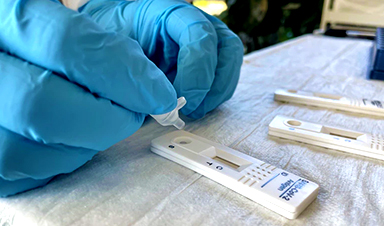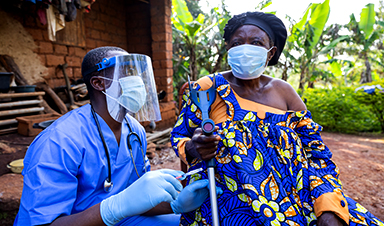The World Health Organization (WHO) and Centers for Disease Control and Prevention (CDC) are tracking and studying a highly mutated new variant of the virus that causes COVID-19. Officially titled BA.2.86 and nicknamed Pirola on social media, the WHO has designated it as a “variant under monitoring.” This status applies to variants that have an unusually large number of mutations that call for monitoring as they spread.
According to Fred Hutchinson Cancer Center evolutionary biologist Jesse Bloom, BA.2.86 has more than 30 amino acid changes in its spike protein, compared with its next closest ancestor (Omicron’s BA.2 subvariant).
“We have not seen a new variant [in humans] with this many new spike mutations happening all at once since the emergence of the original Omicron,” Bloom told NBC News. “Based on the sequence, I think we can be very confident this [variant] is going to be relatively good at evading the antibodies that most people have from prior infections and vaccinations. What we still don’t know is, is this variant good enough at transmitting that it will really be able to spread widely around the world?”
So far, only six sequences BA.2.86 have been reported in the United States, United Kingdom, Israel, and Denmark, but epidemiologists are concerned that it is circulating in more places since monitoring COVID-19 variants has dropped.
“It is unusual for corona to change so significantly and develop 30 new mutations. The last time we saw such a big change was when Omicron appeared,” Morten Rasmussen, a senior researcher at the Statens Serum Institut (SSI) in Denmark, said in a statement.
SSI scientists stressed that it is currently too early to say if this new variant is more contagious or severe and that they are in the process testing it against human antibodies.
The CDC will keep monitoring BA.2.86, but did not say it is not currently a cause for alarm. According to the CDC’s variant tracker, the XBB descendant EG.5 (nicknamed Eris) is causing roughly 20 percent of all new COVID-19 cases in the US and is the dominant variant. The next most common variant is FL.1.5.1, causing about 13 percent new cases.
[Related: Your guide to COVID testing for the unforeseeable future.]
“I think what we are seeing is our detection mechanisms that we’ve put in place are working, right?” CDC Director Mandy Cohen told CNN. “We are more prepared than ever to detect and respond to changes in the COVID-19 virus.”
As the fall and winter virus season approaches, COVID-19 cases are expected to continue to climb around the US. The Food and Drug Administration (FDA) is expected to authorize updated booster shots soon, with signoff from the CDC expected by mid-September. The new boosters won’t include the specific EG.5 subvariant or BA.2.86, but will target the XBB strains.
News
Shocking Amounts of Microplastics in the Brain – It Could Be Increasing Our Risk of Dementia
The brain has higher concentrations of plastic particles compared to other organs, with increased levels found in dementia patients. In a comprehensive commentary published in Brain Medicine, researchers highlight alarming new evidence of microplastic accumulation [...]
Baffling Scientists for Centuries: New Study Unravels Mystery of Static Electricity
ISTA physicists demonstrate that contact electrification depends on the contact history of materials. For centuries, static electricity has intrigued and perplexed scientists. Now, researchers from the Waitukaitis group at the Institute of Science and [...]
Tumor “Stickiness” – Scientists Develop Potential New Way To Predict Cancer’s Spread
UC San Diego researchers have developed a device that predicts breast cancer aggressiveness by measuring tumor cell adhesion. Weakly adherent cells indicate a higher risk of metastasis, especially in early-stage DCIS. This innovation could [...]
Scientists Just Watched Atoms Move for the First Time Using AI
Scientists have developed a groundbreaking AI-driven technique that reveals the hidden movements of nanoparticles, essential in materials science, pharmaceuticals, and electronics. By integrating artificial intelligence with electron microscopy, researchers can now visualize atomic-level changes that were [...]
Scientists Sound Alarm: “Safe” Antibiotic Has Led to an Almost Untreatable Superbug
A recent study reveals that an antibiotic used for liver disease patients may increase their risk of contracting a dangerous superbug. An international team of researchers has discovered that rifaximin, a commonly prescribed antibiotic [...]
Scientists Discover Natural Compound That Stops Cancer Progression
A discovery led by OHSU was made possible by years of study conducted by University of Portland undergraduates. Scientists have discovered a natural compound that can halt a key process involved in the progression [...]
Scientists Just Discovered an RNA That Repairs DNA Damage – And It’s a Game-Changer
Our DNA is constantly under threat — from cell division errors to external factors like sunlight and smoking. Fortunately, cells have intricate repair mechanisms to counteract this damage. Scientists have uncovered a surprising role played by [...]
What Scientists Just Discovered About COVID-19’s Hidden Death Toll
COVID-19 didn’t just claim lives directly—it reshaped mortality patterns worldwide. A major international study found that life expectancy plummeted across most of the 24 analyzed countries, with additional deaths from cardiovascular disease, substance abuse, and mental [...]
Self-Propelled Nanoparticles Improve Immunotherapy for Non-Invasive Bladder Cancer
A study led by Pohang University of Science and Technology (POSTECH) and the Institute for Bioengineering of Catalonia (IBEC) in South Korea details the creation of urea-powered nanomotors that enhance immunotherapy for bladder cancer. The nanomotors [...]
Scientists Develop New System That Produces Drinking Water From Thin Air
UT Austin researchers have developed a biodegradable, biomass-based hydrogel that efficiently extracts drinkable water from the air, offering a scalable, sustainable solution for water access in off-grid communities, emergency relief, and agriculture. Discarded food [...]
AI Unveils Hidden Nanoparticles – A Breakthrough in Early Disease Detection
Deep Nanometry (DNM) is an innovative technique combining high-speed optical detection with AI-driven noise reduction, allowing researchers to find rare nanoparticles like extracellular vesicles (EVs). Since EVs play a role in disease detection, DNM [...]
Inhalable nanoparticles could help treat chronic lung disease
Nanoparticles designed to release antibiotics deep inside the lungs reduced inflammation and improved lung function in mice with symptoms of chronic obstructive pulmonary disease By Grace Wade Delivering medication to the lungs with inhalable nanoparticles [...]
New MRI Study Uncovers Hidden Lung Abnormalities in Children With Long COVID
Long COVID is more than just lingering symptoms—it may have a hidden biological basis that standard medical tests fail to detect. A groundbreaking study using advanced MRI technology has uncovered significant lung abnormalities in [...]
AI Struggles with Abstract Thought: Study Reveals GPT-4’s Limits
While GPT-4 performs well in structured reasoning tasks, a new study shows that its ability to adapt to variations is weak—suggesting AI still lacks true abstract understanding and flexibility in decision-making. Artificial Intelligence (AI), [...]
Turning Off Nerve Signals: Scientists Develop Promising New Pancreatic Cancer Treatment
Pancreatic cancer reprograms nerve cells to fuel its growth, but blocking these connections can shrink tumors and boost treatment effectiveness. Pancreatic cancer is closely linked to the nervous system, according to researchers from the [...]
New human antibody shows promise for Ebola virus treatment
New research led by scientists at La Jolla Institute for Immunology (LJI) reveals the workings of a human antibody called mAb 3A6, which may prove to be an important component for Ebola virus therapeutics. [...]






















